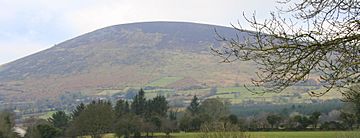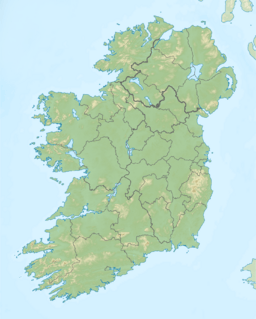Keadeen Mountain facts for kids
Quick facts for kids Keadeen Mountain |
|
|---|---|
| Céidín | |

View from Rathdangan in south
|
|
| Highest point | |
| Elevation | 653 m (2,142 ft) |
| Prominence | 334 m (1,096 ft) |
| Listing | 100 Highest Irish Mountains, Marilyn, Hewitt, Arderin, Simm, Vandeleur-Lynam |
| Naming | |
| English translation | flat-topped hill |
| Language of name | Irish |
| Geography | |
| Location | Wicklow, Ireland |
| Parent range | Wicklow Mountains |
| OSI/OSNI grid | S9539489764 |
| Topo map | OSi Discovery 62 |
| Geology | |
| Mountain type | Dark slate-schist, quartzite & coticule |
Keadeen Mountain is a cool peak in Ireland, standing tall at 653 meters (about 2,142 feet). Its name in Irish is Céidín, which means "flat-topped hill." It's listed as one of the highest mountains in Ireland on different mountain lists.
Keadeen Mountain is found at the very southwest end of the Wicklow Mountains. It's on its own small group of mountains, separate from the bigger Lugnaquilla area. From Keadeen, you can look down over the beautiful Glen of Imaal to the south.
The Name of Keadeen
The name "Keadeen" also belongs to a nearby area called a townland in Kilranelagh. An expert named Paul Tempan says that the mountain was sometimes called Céidín Uí Mháil in Irish. This longer name came from the local people who gave their name to the nearby Glen of Imaal.
Keadeen's Place in History
Keadeen Mountain has a special place in Irish history. At its northern base, in a spot called Derrynamuck, you'll find the Dwyer–McAllister Cottage. This cottage is famous because of a brave leader named Michael Dwyer.
In December 1799, during the Irish rebellion of 1798, Michael Dwyer was a leader of the Society of United Irishmen. British soldiers surrounded Sam McAllister's cottage where Dwyer was hiding. But Dwyer managed to escape the siege by climbing up the slopes of Keadeen Mountain.


